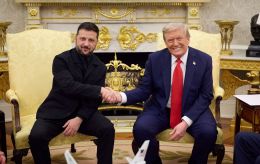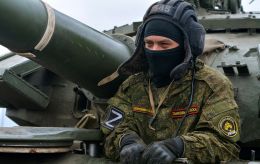Fifth month of Ukraine's counteroffensive and possible threat from Wagner 2.0: Frontline overview
 Photo: Ukrainian military press on the Russians near Bakhmut and in the south (facebook.com/MinistryofDefenceUA)
Photo: Ukrainian military press on the Russians near Bakhmut and in the south (facebook.com/MinistryofDefenceUA)
Ukrainian troops are entering the fifth month of their offensive with tactical successes in the south and near Bakhmut, while Russia is preparing a counterattack. The situation on the battlefield and new possible threats are analyzed in the RBC-Ukraine review.
To prepare this material, official military spokespersons, government representatives, and commanders' statements were used, as well as analytical data from the American Institute for the Study of War (ISW) and the DeepState project, along with expert comments for RBC-Ukraine.
Show of muscle: What Russia is preparing on the Lyman-Kupiansk front
After relative calm, the enemy resumed assaults on the Lyman-Kupiansk front. According to the spokesperson for the Military Group East of the Armed Forces of Ukraine, Illya Yevlash, the Russians are attempting to break through, but the defense forces are repelling the attacks.
"They (the enemy) suffered losses and withdrew, giving up on offensive actions," he commented on one of the episodes.
Russian aviation is actively involved in this area, and the daily shelling has already exceeded 500. In the Synkivka area near Kupiansk, attempts to improve the tactical situation have been unsuccessful. In the Serebryanske forest near Lyman, it's traditionally intense, but the enemy rarely dares to launch assaults.
"Because fighters from the National Guard's Azov Brigade came there. The Russians treat them with respect and caution because they know they will face such a fierce resistance that little will be left of them," said military expert Colonel Vladyslav Seleznov.
There is no peaceful point along the entire Lyman-Kupiansk axis. Presumably, due to the latest escalation, President Volodymyr Zelenskyy visited the brigade positions in this direction.
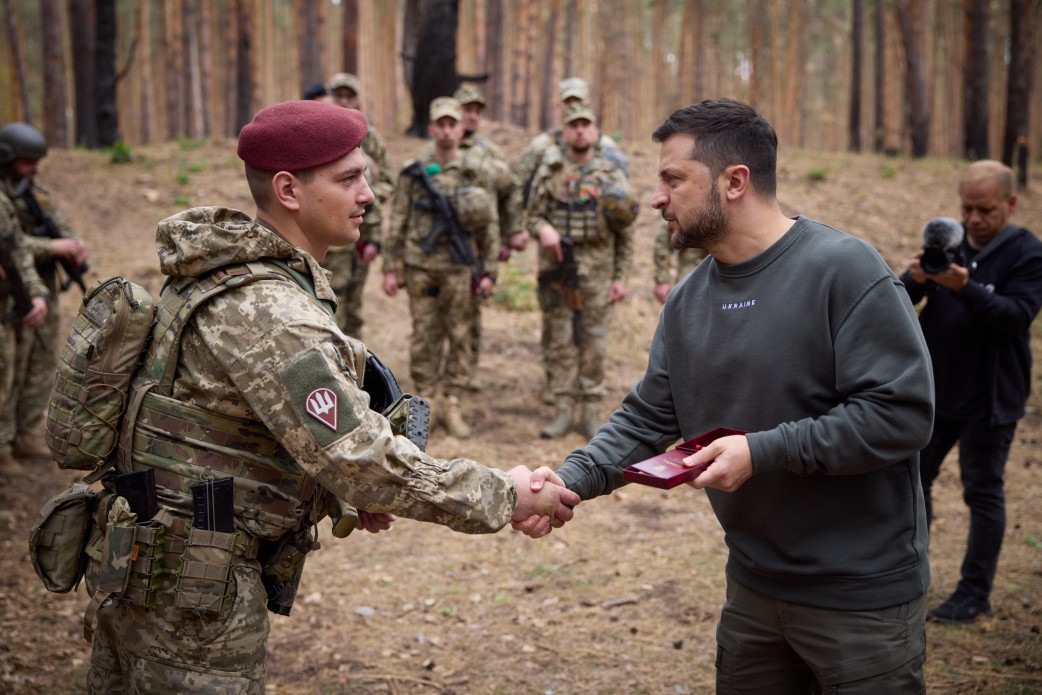
Volodymyr Zelenskyy visited the positions of brigades on the Lyman-Kupiansk axis (Photo: president.gov.ua)
The situation is as follows - the 25th Russian Army has been moved to the east, and its personnel is about 80% complete, with equipment and weaponry at half strength. It is meant to replace the heavily battered 1st Taman and 4th Kantemir divisions, according to Seleznov.
"On the other hand, the 25th Army will be advancing. Ukrainian intelligence reports that the enemy is creating passages in their minefields and bringing armored vehicles to the front line. Such actions are typically taken before offensives or counterattacks, so the enemy is prepared. I am confident they will attempt to push forward to reach the Oskil River and capture the eastern part of Kupiansk with the aim of establishing a defense along the left bank in the occupied part of the Kharkiv region," he noted.
According to him, the so-called "military-civil administration of the Kharkiv region" is still present in Belgorod, and the Russians have not given up hope of gaining control over the entire region.
"Will they succeed? I bet on our Defense Forces. But it should be understood that the success of our army depends directly on resources. These processes will continue if there are enough resources for counterattacks and liberating territories. If resources are limited, our capabilities to repel enemy attacks will also be limited," added the expert.
The Head of the Сenter of Military Law Researches, Oleksandr Musiienko, points out that the occupiers are targeting bridges and transportation infrastructure.
"The enemy is showing intentions to proceed to offensive actions in the east. The calculation is for the end of fall, the beginning of winter, or possibly earlier. So, we will also have to decide on transitioning to active defense. If we talk about a war of attrition, exhausting and destroying the enemy in large numbers is most effective in active defense," he emphasized in the conversation.
Ukrainian Armed Forces are advancing near Bakhmut, the enemy is not going to retreat
In the east, the Ukrainian offensive continues to the south of Bakhmut. After the liberation of the villages of Klishchiivka and Andriivka, battles unfolded along the railway, with some parts successfully taken, and to the east of Andriivka, more advantageous positions were occupied.
The Russians are responding with the deployment of reserves and counterattacks. According to DeepState analysts, a real meat grinder began last week. Despite the partial withdrawal of the enemy from the railway, the area is still littered with bodies.
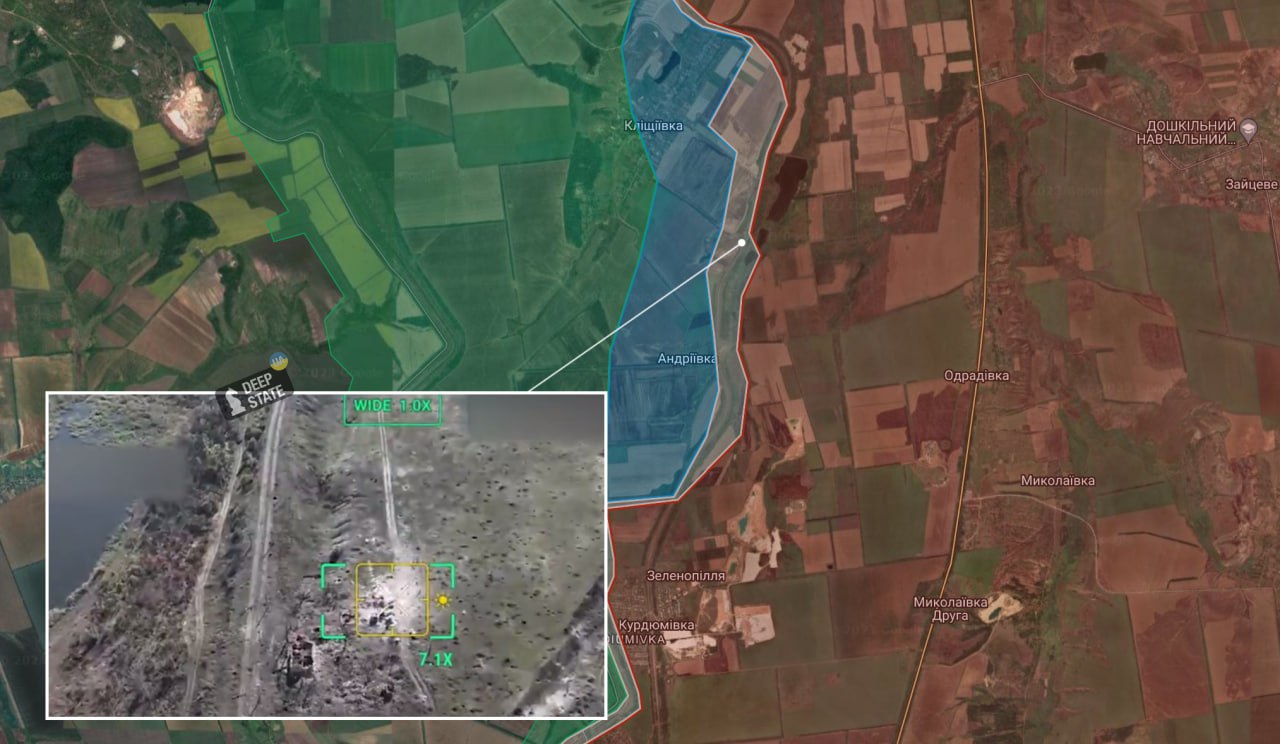
To the east of Andriivka, near Bakhmut, a real meat grinder has begun (Photo: t.me/DeepStateUA)
On the northern flank, the Defense Forces are stuck near the village of Berkhivka, the liberation of which would allow them to occupy adjacent heights. Without this, a semi-encirclement of the city, the de-occupation of which was recently promised by Volodymyr Zelenskyy, is impossible.
"The enemy understands the importance of the northern flank near Bakhmut because its loss could lead not only to a fire but to a real semi-encirclement. Of course, it will be harder for the enemy to defend when our forces are on all sides," said Illya Yevlash.
The Russians have concentrated 10,000 troops in the city, and they are not planning to leave Bakhmut until they have to. This is partly because attempts to regain lost positions on the southern flank have not stopped, emphasized Oleksandr Musiienko.
Currently, the Defense Forces are moving toward the T0513 road to cut off one of the supply routes for the Russian group in Bakhmut. Partial control over the road from the occupied Horlivka was reported last week.
Expert Vladyslav Seleznov says that after Russian propaganda has been heating up the audience with the Bakhmut issue for 10 months, losing it is not an option now. Especially, before Vladimir Putin announces his participation in elections in November.
In the expert's opinion, there is currently no reason to believe that actions to liberate Bakhmut will accelerate.
"Overall, about 50,000 Russians and a significant amount of resources are concentrated on the Bakhmut direction. Of course, the fortification network here is not as powerful as the Surovikin Line in the south; they simply didn't have time to build it. The enemy constantly counterattacks, so it's probably not worth saying that the situation will fundamentally change shortly," he explained.
Southern front: Russia's building railway and preparing for battle for Tokmak
In the south, the focus remains on two villages - Novoprokopivka and Verbove, Zaporizhia region. However, as stated by the spokesperson of the Tavria Defense Forces, Oleksandr Shtupun, the enemy is pressing along the entire front from Avdiivka to Robotyne, and the number of military clashes has nearly doubled.
Representative of the National Guard, Mykola Urshalovych, reported successes in the south thanks to the assault units of the 15th Operational Brigade, which are pressing the Russians and consolidating new positions.
Analysts from the Institute for the Study of War reported advancements to the northwest of Robotyne, and the Ukrainian DeepState project reported the repelling of a Russian counterattack near Novoprokopivka and battles in the Verbove area. Videos confirming the breach of the Surovikin Line concrete pyramids are appearing online. However, a full breakthrough is not yet achieved in all places.
According to the occupiers, construction of a railway branch from Rostov-on-Don to Melitopol via Mariupol and Berdyansk has begun approximately 60 kilometers from the front line.
Experts interviewed by RBC-Ukraine agree that the enemy is preparing to lose Tokmak. A few days ago, the commander of the operational-strategic group of forces Tavria, Oleksandr Tarnavskyi, referred to it as the minimum task of the current counteroffensive.
"The Russians are preparing a foothold for defense in case our forces break through and take Tokmak. They are considering transitioning to defensive operations from the Melitopol area," says Oleksandr Musiienko.
Vladyslav Seleznov reminds us that this is a war of resources, and the side that is fully and timely supplied has the advantage on the battlefield. As soon as Ukrainian forces approach Tokmak, they will gain control of the railway hub leading to Crimea. Therefore, the occupiers are rushing to build a new branch closer to the Azov Sea coast. Technically, this is feasible since they have large railway forces.
"There is information that they are preparing to build a railway bridge over the Kalmius River, and there is a project for a broader road in the south of the Donetsk region. Basically, the enemy is repeating the Crimean tactics. The Tavryda highway is definitely not about tourists at resorts; it's about military logistics to quickly transport cargo between Kerch and Sevastopol," added Seleznov.
Wagner 2.0: Why mercenaries were sent to war again and what threats exist
Mercenaries of the Russian Wagner private military company have once again entered eastern Ukraine after four months. Following the elimination of their leader, Yevgeny Prigozhin, some of the groups disbanded in Belarus, and some members went to Africa, while the rest returned to the war.
According to Mykhailo Podolyak, an advisor to the head of the President's Office, these remnants are filling gaps in the Bakhmut direction, and the PMC no longer exists. Meanwhile, the ISW paid attention to Putin's orders to one of the former Wagner leaders to recruit volunteers and information about Prigozhin's 25-year-old son allegedly negotiating the transition of mercenaries to the Russian National Guard.
It is expected that the Wagner mercenaries will not need to sign contracts with the Ministry of Defense; they will retain their name, symbolism, command structure, and principles of operation. Based on this, analysts are revising their assessments and speculate that Wagner could become a serious threat, but not everyone agrees.
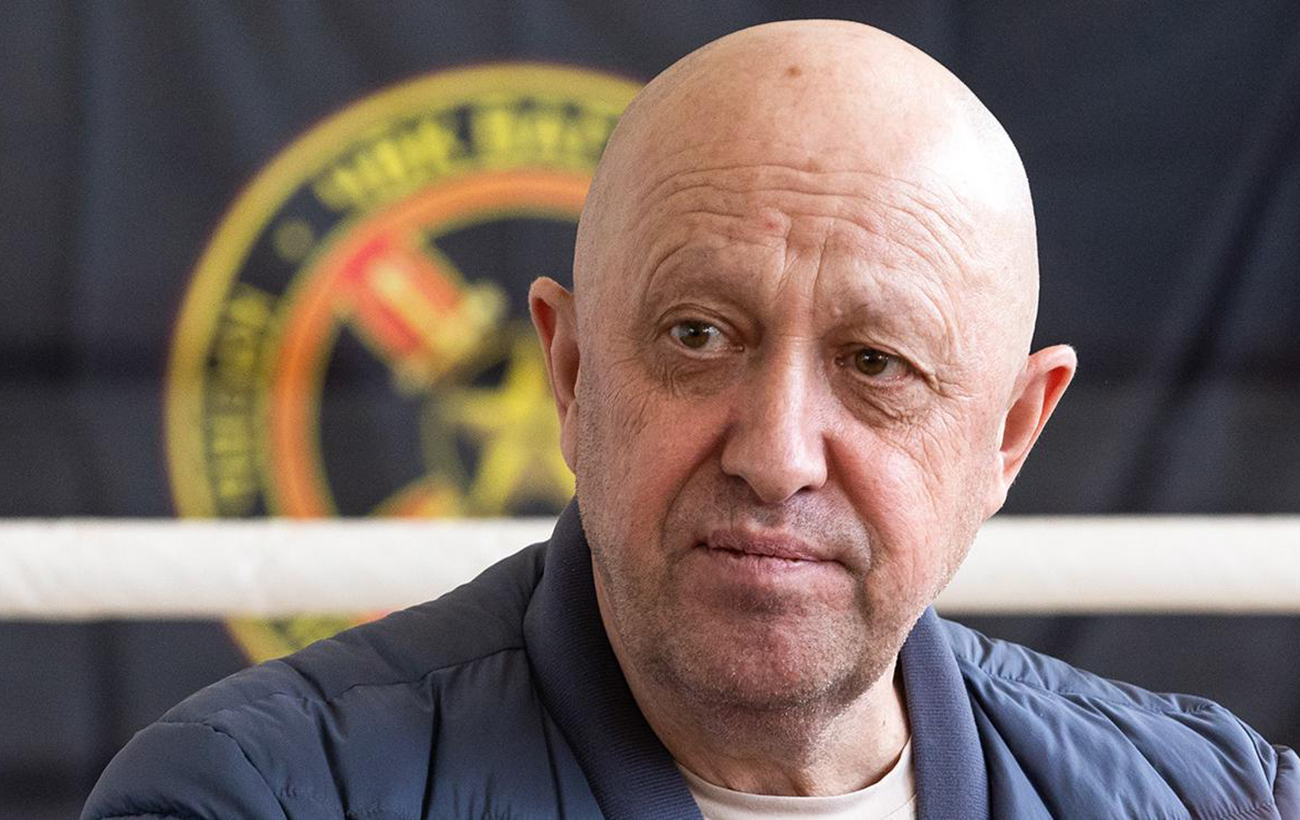
After the elimination of Yevgeny Prigozhin, it is unlikely that the Wagner mercenaries will be able to restore the combat readiness they had under his leadership (Photo: Russian media)
"If we talk about 'Wagner 2.0,' there are between 4,000 and 5,000 of them on the occupied territories of Ukraine. They are being integrated with units of other PMCs, such as Storm Z, Lynx, Veterans, Tiger, and so on. These are the ones who couldn't find a place in Africa and went to war to make money," explained Oleksandr Musiienko to RBC-Ukraine.
Vladyslav Seleznov also doubts the significant threat from the remnants of the Wagner group.
"I don't think Wagner survived as a phenomenon after Prigozhin's elimination. Can these remnants act as effectively as they did before? My answer is no. They lack the necessary support, and the successors of Yevgeny Prigozhin and Dmitry Utkin are unlikely to organize combat operations at a high level. Wagner's key advantage was prisoners whom they sent in large numbers on 'meat' assaults. It's unlikely that this system of subordination and formation of strike groups can be replicated in other assault units," explained the expert.
Russia's Black Sea fleet experiences a 'functional defeat': What does it mean?
Ukraine has gained the upper hand on the maritime front without having a conventional military navy. Thanks to special forces operations, missile strikes, and air and naval drones, Russian ships cannot feel safe in Sevastopol, Novorossiysk, or blue waters.
Attacks on military targets in Crimea intensified in August, and since then the S-400 air defense systems, the large landing ship Minsk, and the submarine Rostov-on-Don in Sevastopol, while other vessels sustained damage. The culmination was the destruction of the headquarters of the Russian Black Sea Fleet with high-ranking officers.
Commenting on Ukraine's southern offensive, British Minister of State for Armed Forces James Heappey stated at a forum in Warsaw that Ukraine has achieved significant success not on land but at sea.
"Look at what Ukraine has now done in the Black Sea! Ukraine has achieved the functional defeat of the Russian Black Sea Fleet," he said.
By "functional defeat," he meant that Russia could not fully utilize its fleet, explained Oleksandr Musiienko.
"They cannot land troops, besiege our ports, or establish a complete blockade. They cannot shell our coast and use ships for fire support. The role of the Russian fleet has been reduced to occasional missile launches and occasional patrols. But again, only in neutral waters north of the Bosporus. That's essentially it," summarized Musiienko.
